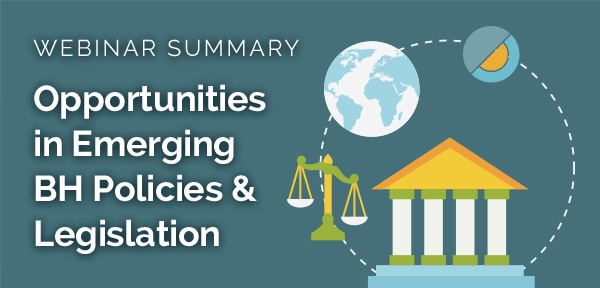Webinar Summary: The Opportunities (& Technology Requirements) in Emerging Behavioral Health Policies and Legislation
by Core Solutions on May 2, 2016

During our latest webinar, “The Opportunities (& Technology Requirements) in Emerging Behavioral Health Policies and Legislation,” we discussed the implications and opportunities of recent policy initiatives announced by the Department of Health and Human Services agencies. In the summary below, you will learn how to utilize emerging policy opportunities to further your organization’s efforts to increase client engagement and integrate care through a range of funding and recognize the technology options needed to gain a competitive advantage.
The BH Organization of Today Will Need to Change
The U.S. healthcare system is rapidly changing to be patient-centric, data-driven and built on state and federal policies that are focused on payment reform and information use in integrated systems. To survive and thrive in this new environment, behavioral health organizations need to prepare for structural changes in service delivery and health information exchange (HIE). These structural changes stem from five inescapable elements that all providers are struggling with, including:
- Payment Reform: New models of financial risk and reimbursement and payment that is increasingly tied to quality metrics.
- Delivery of Care: Providers are increasingly responsible for managing the health outcomes of various populations of patients, not just treating individuals within their own clinical setting. New roles and systems for coordinating care across the continuum are needed in this environment.
- Data Access and Analysis: Providers and payers face the challenge of accessing and integrating data from many clinical, operational, administrative and patient-derived sources. Access is essential for improving care, designing cost-effective programs and managing financial risk.
- Sharing Information: Coordination of care across providers requires information exchange among payers, community organizations, and patients, as well as the involved providers. Technological capacity must be scalable to meet emerging requirements.
- Culture Change: Leaders need to guide their organizations and change every day practices.
These transformative elements beget the need for provider competencies in tech enhanced patient-centered care, patient engagement and activation, interprofessional team-based care, evidence-based practices, quality metrics, real-time data, and information sharing via HIE.
The Policies Driving the Need for Change
- The BH Policy from SAMHSA: Certified CBHC Planning Grants, 42 CFR: Requires state and local infrastructure sufficient to support payment reform, integrated care, clinical decision support, patient engagement, and population health. Additionally, NPRM for 42 CFR, Part 2 and HIE will influence connectivity with health information exchange and consent processes moving forward.
- Medicare Access and CHIP Reauthorization Act (MACRA) 2015: Instituted significant policy changes and advanced the role for patient engagement activities in four areas: practice improvement activities for the merit-based incentive payment system (MIPS), patient-reported outcome measures and patient experience measures, expansion of telehealth, and provider transparency. This Act creates financial incentives and penalties around patient engagement, lays the groundwork for increasingly patient-centered healthcare payment and delivery systems that actively incorporate the patient into the care team to achieve lower costs and better health outcomes.
- Medicaid Levers for HIE and Interoperability: States may leverage the FFS model to promote HIE use among Medicaid providers through a higher FFS rate to providers who use HIE than providers who do not; State Medicaid Contracts with MCOs can include HIE in State Quality; Strategy and External Quality Review (matched at 75%); 1115 Waivers and State Plan Amendments with special terms and conditions tied to certified HIT and HIE; HITECH match on core HIE services, public health and eCQM infrastructure; Delivery System Reform Incentive Payment Programs through Medicaid waiver; and SMD letter allowing 90% FFP for HIE connectivity for BH & others.
- State Levers for HIE and Interoperability: States may leverage conditions of HIE Network Participation, i.e., Qualified Health Plans in DHIN, MN, MA requirement for certified EHRs; and Alignment of eCQMs (AKA CQF) and reporting infrastructure across payers.
Preparing for the Changes from the Inside Out
Establishing readiness for these changes will require a written information strategy that includes adoption and use of consumer-facing technologies, analytics, interoperability, payment reform and state statutes, while also meeting current requirements across data systems and predictive analytics. To achieve this difficult task, there are key areas that your organization must assess for readiness, including leadership, strategic plans, financial capacity, payment reform, data integration and exchange, process improvement, and culture change. With technology at the epicenter of these key evaluation areas, it is necessary to place a critical eye on your organization’s adoption of health information technology (HIT) at various levels, as well as take the necessary steps for fostering a culture of change.
- HIT Evaluation: Consider the various forms of HIT in order of importance by way of the HIT Pyramid that places IoT at the top, followed by Business Intelligence, Population Health, Consumer Engagement, Healthcare Mobility, Telemedicine, and at the foundation, EHR. Next, assess how much of your total operating budget is dedicated to HIT.
- Data-Driven Culture: Being data-driven requires a data culture that maintains well-designed KPIs tied to organizational strategy and eliminates silos to foster an open, sharing culture. This culture also requires strong leadership commitment with clear methods for measuring success, a willingness to establish and participate in data governance, and the ability to develop strong data literacy.
- Behavioral Health (32)
- AI in Healthcare (17)
- EHR (16)
- I/DD (15)
- Mental Health (14)
- Revenue Cycle Management (12)
- CCBHC (11)
- Electronic Health Records (9)
- Crisis Center (8)
- COVID-19 (4)
- Substance Abuse (3)
- Augmented Intelligence (2)
- Care Coordination (2)
- Billing (1)
- Checklist (1)
- Substance Use (1)
- Telebehavioral Health (1)
